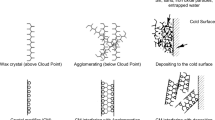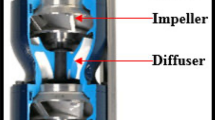Abstract
Differential sticking arises in drilling operations when the drillstring embeds into a layer of mud on the borehole wall. The present work is aimed at proving the concept of an unconventional method of releasing the drill string, namely, the application of an electrical current. An instrument has been designed and constructed to measure the slippage torque at the interface between a steel disc and a filtercake prepared from a model aqueous drilling mud. Experiments have demonstrated that a cathodic current of 1 mA cm−2 reduced the slippage torque by about 50% with both mild and stainless steel. The same effect was obtained galvanically, using a magnesium sacrificial anode connected to the steel, thus dispensing with the need for an external power source. It is hoped that this effect could be used to inhibit differential sticking in aqueous drilling muds, as well as offering a fast method of stuck pipe release.
Similar content being viewed by others
References
W. E. Hemick and A. J. Longley, Drill and Prod. Prac. 1 (1957) 55–61.
D. A. Krol, Oil & Gas J. Technol. 1 (1984) 55–9.
M. R. Annis and P. H. Monaghan, J. Pet. Technol. 14 (May) (1962) 537–43.
Y. M. Bushnell-Watson and S. S. Panesar, ‘Differential sticking laboratory tests can improve mud design’, SPE 22549, presented at the 66th conference SPE, Dallas, TX, 6–9 Oct. (1991).
R. H. Clark and S. G. Almquist, ‘Evaluation of spotting fluids in a full scale differential pressure sticking apparatus’, SPE 22550, presented at the 66th conference SPE, Dallas, TX, 6–9 Oct. (1991).
R. M. Khasayev, R. B. Kuliyev and G. A. Dzhabrailov, Neft. Khoz. (5) (1983) 22–4.
N. P. Brandon and R. J. K. Wood, Wear 170 (1993) 33–8.
D. G. Frank, V. K. Chia, M. R. Schneider and A. T. Hubbard Langmuir 3 (1987) 860–6.
H. C. Brookes, J. W. Bayles and F. J. Graham J. Appl. Electrochem. 20 (1990) 223–30.
W. J. Moore, ‘Physical chemistry’, Longmans (1974), p. 430.
N. P. Brandon, S. S. Panesar, N. Bonanos, P. O. Fogarty and M. N. Mahmood, J. Petrol Sci. Eng. 10 (1993) 7582.
G. V. Chilingarian, personal communication (1993).
E. Donaldson, G. V. Chilingarian and T. Yen, ‘Enhanced Oil Recovery II, Process and Operations’, Develop. Petrol. Sci. 178 Elsevier, Amsterdam (1989) p. 9.
G. V. Chilingarian, J. Petrol. Sci. Eng. 5 (1991) 293–5.
G. V. Chilingarian, K. S. Chang, J. E. Davis, H. J. Faranghi, L. G. Adamson and S. Sawabini, Compass of Sigma Gamma Epsilon 45(4) (1968) 272–85.
Author information
Authors and Affiliations
Rights and permissions
About this article
Cite this article
Bonanos, N., Brandon, N.P., Mahmood, M.N. et al. The effect of imposed electrical current on torque release at the metal-mudcake interface. J Appl Electrochem 26, 977–980 (1996). https://doi.org/10.1007/BF00242051
Received:
Revised:
Issue Date:
DOI: https://doi.org/10.1007/BF00242051




